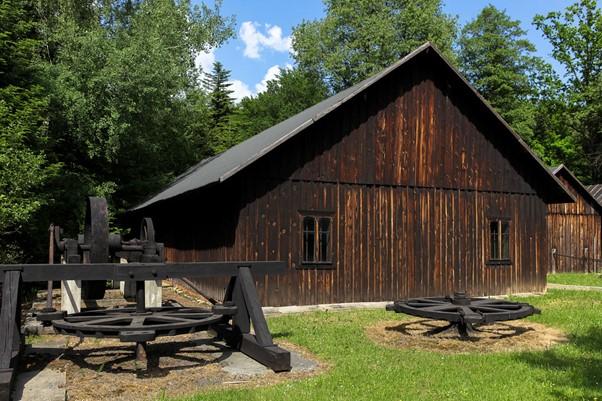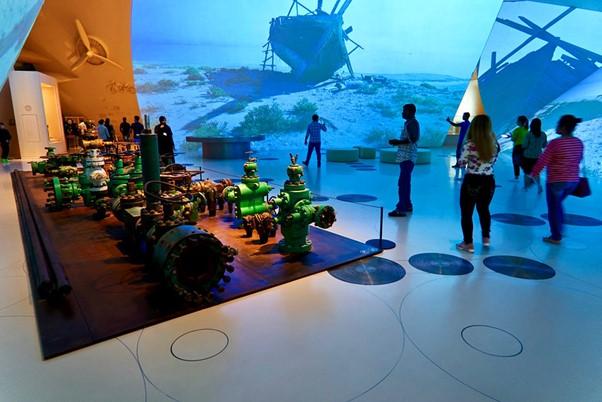Leyla Sayfutdinova
The oil and gas industry currently produce well over half of the energy that is consumed in the world (Ritchie 2020). Yet, the climate crisis and the unfolding energy transition may mean that the dominant position of the oil and gas industry in global energy production is changing. What is the place of oil in this transition? What will become of the industry’s enormous infrastructure? How will the oil industry be remembered in the many local communities which have been shaped by it for generations? These were the central questions of the five-day virtual workshop “A place for oil: memory of oil and place in museums across the world” which Leyla Sayfutdinova organized with the Centre for Energy Ethics at the University of St Andrews.
The cross-sectoral workshop brought together museum practitioners and academics working on oil industry heritage from across the world. We sought to cover a diverse range of historical experiences with oil and thus included offshore and onshore, and pioneers of the industry in the 19th century as well as current producers. The workshop started ‘locally’ and focused on the memorialization of the oil industry in the North Sea, with a keynote by Dr Sam Alberti and Elli Swinbank on “Curating North Sea oil” at the National Museum of Scotland and a virtual tour of the Norwegian Petroleum Museum in Stavanger, curated and narrated by Dr Bjorn Lindberg.
In the days following, the geography was expanded to include Eastern Europe, the Persian Gulf, the Caspian Sea, the Caribbean, Canada, and the north of Russia. One of our aims was to explore the memorialization of oil in localities that are not often part of the mainstream discussion of the industry despite having experienced its significant impact. This was done through presentations from smaller museums in early oil regions in Eastern Europe such as Ploiesti in Romania and Bobrka in Polish Galicia (fig. 1), as well as Ukhta in Northern Russia. We also looked beyond the oil industry and explored the parallels with memorialization of an older ‘sister’ fossil fuel industry, coal, through a talk on the local mining museums in the UK and Ukraine.

The workshop helped to identify two key dimensions for future thinking about memorialization of oil heritage. One is the relationship between memorialization and time. Several museums which presented their collections in the workshop focus on the past of the industry in their locales, for example, the National Oil Museum in Oil springs, Ontario, and National Petroleum Museum of Romania. However, a few museums challenge this traditional approach to history, and instead focus on the present (Alberti et al, 2018), by collecting and exhibiting contemporary oil technology. This is the case, for example, in the National Museum of Scotland, Norwegian Petroleum Museum (fig. 2) and the Wiess Energy Hall in Houston, Texas.
In other contexts, the entanglement of the industry in the present and its discontents can prevent memorialization in museums. This was the topic of the special panel on “Museums that never happened”, focusing on Azerbaijan and Venezuela. These countries have a long-lasting engagement with the oil industry in common, which has been crucial for the shaping of both their economies and national cultures. Despite this, dedicated oil museums exist in neither of them. The speakers of the panel argued that it is difficult to represent an industry which is not only contemporary but remains deeply integrated into everyday life.

The theme of time was also examined in more detail in a presentation on the oil heritage in Iran, which traced dramatic transformation of the narratives on oil since the middle of 20th century. The official narrative of oil changed from seeing it as a source of national pride in the period before the Islamic Revolution of 1979, to a tool of colonialism in the early post-revolutionary period. In the last decade oil began to be re-integrated into the national narrative. Currently, there is a state program of centralized petroleum museums that would collect and exhibit oil industry heritage in different cities.
Another important theme was the issue of scale. The workshop initially focused on the level of locality: the level of towns and regions where oil was produced. Yet in all presentations, larger scales of significance became immediately apparent. In many cases, oil has been important for the nation-state, even if its production has been concentrated in a specific locality. Thus, in Venezuela and Azerbaijan, oil production has been intertwined with the construction of the nation-state and national identity; in Iran, it has been a source of national pride in Shah’s period, and in Romania and Qatar oil industry served as a backbone of the national economy. Yet in Qatar, despite the economic importance of oil, the population has been largely disengaged from it and the industry still remains to be integrated into the national narrative. All the presentations also stressed the inter- and transnational character of the oil industry from its very beginnings. Several museums showed foreign-produced equipment, noted the role of foreign capital in the development of the oil industry in their localities, as well as the role of their local expertise in the global transfer of knowledge in the industry. The interconnectedness of the local and the global in the oil industry was emphasized by Professor Carola Hein in her keynote talk on ‘Global Petroleumscape and oil heritage’, in which she discussed the diversity of oil heritage and the changes in the representations of the oil-built environment in different parts of the world.

The workshop started a much-needed conversation on the place of oil heritage in the energy transition and in imagined post-oil futures. While energy transitions are crucial to resolving the climate crisis, it is important not to lose sight of the new inequalities and the nostalgia that such transitions will generate in many places where oil is or was produced. Experiences from previous industrial transitions, such as the switch from coal mining, as well as some examples of oil museums in this workshop, suggest that oil heritage can play a role in regenerating sites of former production. Beyond material incorporation of the oil heritage into post-oil local infrastructure, reconciling different visions of the oil industry can contribute to a more inclusive post-oil future.
Acknowledgement
Leyla Sayfutdinova is a Marie Curie Fellow at the Centre for Energy Ethics at St. Andrews University. It was edited by the PortCityFutures editorial team: Carola Hein and Hilde Sennema.
References
Alberti, S. J., Cox, E., Phillipson, T., & Taubman, A. (2018). Collecting contemporary science, technology and medicine. Museum Management and Curatorship, 33(5), 402-427.
Hein, C. (2018), "Oil Spaces: The Global Petroleumscape in the Rotterdam/The Hague area." Journal of Urban History 44(5): 887–929.
Ritchie, H. (2020). Our World in Data: Energy mix. https://ourworldindata.org/energy-mix
